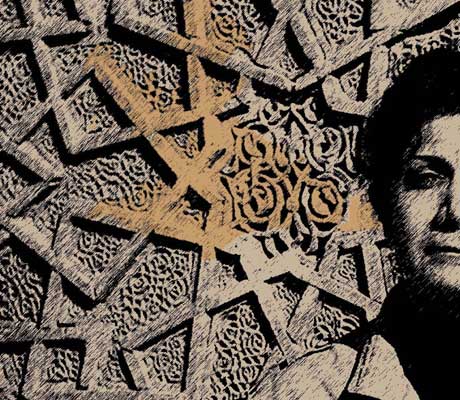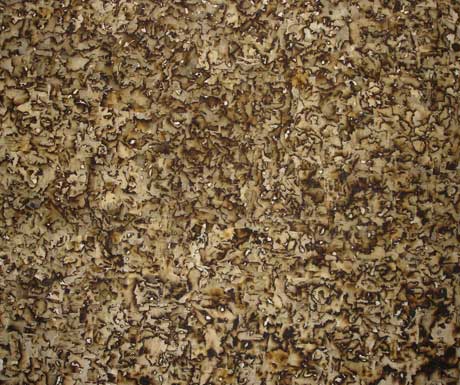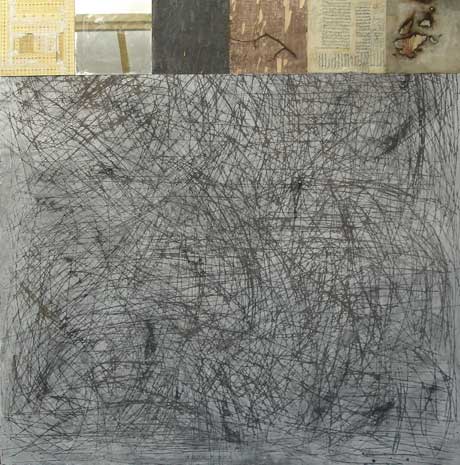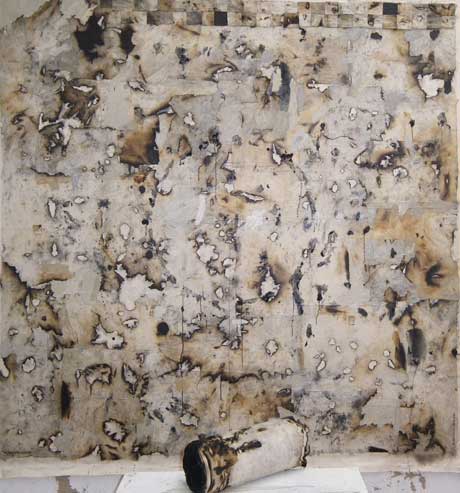Vivid Ruins
Many layers of burned clothes on canvas, mirror and string
300x300cm
2009

Hanaa Malallah is regarded as Iraq’s leading female contemporary artist and a key member of the so-called ‘Eighties Generation’. The term was coined by critics in June 1991 during an exhibition held at the Art Centre in Baghdad of ten emerging artists whose maturation coincided with the outbreak of the Iran-Iraq war (1980-1988) and the first Gulf War beginning with the annexation of Kuwait by Saddam Hussein in 1990. As a group they are foremost connected by the choice to stay, study and practice in Iraq and their work reflects these decisions.
Severe travel restrictions, economic hardship and the social instability that comes with relentless armed conflict led to a gradual distancing from the regional and international art world. Near-total financial and trade embargoes enforced by the United Nations Security Council and lasting until the US-led invasion of Iraq in 2003 only reinforced this isolation. These circumstances radically affected collective art practice and the theory underpinning creative processes. Consequently, the artists of the Eighties Generation have advanced a distinctive and recognisable aesthetic and an approach to art production simultaneously located in the Mesopotamian past and reflecting Iraqi reality during this period. In art historical terms, they may be considered an art movement or school of significant importance.
The three works presented here, Vivid Ruins, Vivid Ruins III and a homage to Iraq̢۪s most influential artist and teacher, For Shaker Hassan, were all created in 2009 in London and are the products of Malallah̢۪s ongoing experiments with abstraction since 1990. Her works are burnt, torn, scratched and assembled, often accompanied by a faint odour of smoke. Yet, for all their painful allusions to the destruction of her native land, Malallah̢۪s works connect to a spiritual notion of transience beyond geography and history.
Over the last few years, Malallah has advanced a sophisticated theory of abstraction, asserting that if any image (figurative or abstract) is distilled to its rudimentary components, the end result can only be abstraction. From this, she deduces that all representation must, ultimately, be considered a collection of abstract symbolic systems. These have been in use since pre-literate times and consequently have embedded within all subsequent systems (writing, numbers, etc.). For abstraction to have value, she argues, it must have these roots. Malallah negotiates her inquiry into abstraction at the intersection of these symbolic systems, which, in the end, all have their origins in the Mesopotamian past.
This theoretic framework has its source in Ludwig Wittgenstein̢۪s Tractatus Logico-Philosophicus, an epistemological treaty on the relationship between language and reality, where he presupposes that philosophical enquiry can only show the commonality between fact and its logical picture. A thin volume containing a series of numbered short statements, Wittgenstein̢۪s Tractatus is considered one of the most influential philosophical works of the 20th century. 2.17, an elaboration of his Theory of Symbols presumes that we create pictures of facts which serve as our models of reality and insists that the elements of these pictures must correspond to this reality. Representation thus must share a logical form with the fact.
Malallah reality of 35 years of life and work in a war-torn country emanates from the very form of her work. Her recent formulation of what she call ruin’s technique, an uniquely Iraqi aesthetic model for interpreting marks of destruction on archaeological material as modern idiom, has placed her among Iraq’s leading artists/art theorists, a position long held by her mentor Shaker Hassan Al Said. The consistent employment of this technique among the ‘Eighties Generation’ artists would tempt an art historian to propose the term ‘Ruinism’ as an independent art movement.
Hanaa Malallah was born in Theegar, Iraq and has been studying art since the age of 15. She matriculated in graphic art at the Institute of Fine Arts in Baghdad, gained an MA in painting from the Academy of Fine Arts, Baghdad which was followed by a PhD in art theory. Until her recent departure from Iraq under the Scholars at Risk program, Malallah headed the Graphic Art Department at the Institute of Fine Art and lectured at the Academy. Her work is in numerous private and public collections and recently came to auction, where it sold far above its estimated price.
CP 2009

Many layers of burned clothes on canvas, mirror and string
300x300cm
2009

Mixed media on wood, mirror, rulers, branch, manuscript and burned clothes
120x120cm
2009

Many layers of burned and folded canvas
Variable dimensions, main body 165x165cm
2009